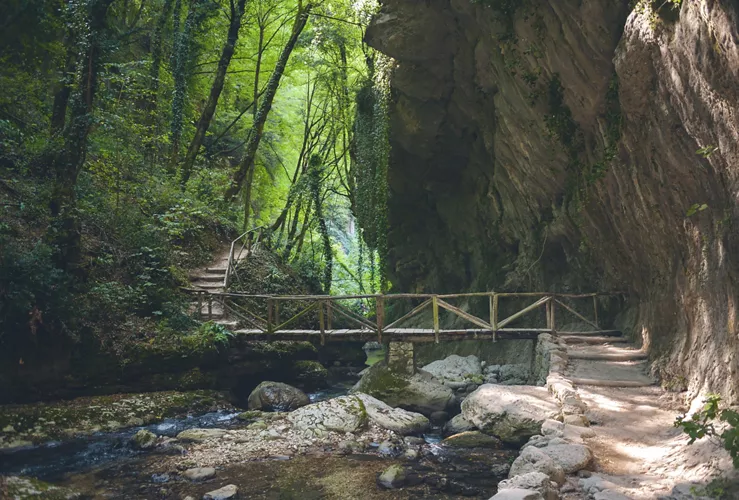This content was automatically translated. View the original text.

Overview
Majella National Park, one of the wildest areas in Italy
The Majella National Park protects a vast area of high mountains in the Abruzzo Apennines between the provinces of Chieti, L'Aquila and Pescara.
The karstic nature of the rocks makes it a place rich in caves, where animals hibernate and where people have built hermitages and places of worship.
Crossing its plateaus nestled between imposing mountains is an exciting experience, which can also be enjoyed on a spectacular railway route known as the Trans-Siberian Railway of Italy.
A mountain of caves, hermitages and tholos
The Majella is a rocky landscape shaped by groundwater and spirituality. The rocks are limestone and are easily infiltrated by rainwater and melting snow, creating an endless number of caves, 100 of which have been counted, some frequented by speleologists and accessible to tourists, others left to the true inhabitants of the mountain, the animals.
The two most beautiful caves are the Cavallone, in the Vallone di Taranta, a karstic complex 1.3 kilometres long and with abundant stalagmites and stalactites, open to visitors. Then there is the Grotta Nera (Black Cave), in the Pennapiedimonte area, which is only accessible to a few experts, for conservation reasons: in this cavern there is 'mountain milk', a particular form of soft, water-soaked concretion formed by the interaction with certain bacteria, which creates whitish stalactite-like deposits called 'trays', the largest known in Italy.
The Majella has always been beloved by monks and hermits, who have built some twenty rock sanctuaries in the most spectacular locations, such as San Bartolomeo in Legio (Roccamorice), set in the rock and accessed through a tunnel carved into the mountain.
The Monastery of San Martino in Valle, next to the gorges of Fara San Martino, and the Hermitage of Sant'Onofrio di Serramonacesca, built on a ridge under a giant boulder, are also spectacular.
The soft limestone rock was used as construction material by farmers to build shelters, barns and small storerooms that they call tholos here. They are frequently seen along the paths that cross the park: they are constructions that are reminiscent in shape and workmanship of the nuraghi of Sardinia or the dammusi of Pantelleria, and are protected by the park as part of Abruzzo's agricultural history. Some tholos are of considerable size, up to 6-7 metres high, with a high floor for the pigeon house and an intermediate floor where the bed was placed.
The paths of the Park, of Liberty and of the Spirit
If you want to cross the whole of the Majella, do so along the 83-kilometre-long Park Trail, which runs from Popoli to the station of Palena, crossing the highest peaks such as Mount Amaro (2,793 metres).
If you are interested in stone huts, the characteristic tholos found in the park, there is a path that passes several of them, along the municipalities of Lettomanoppello, Abbateggio, Roccamorice, Caramanico, and Serramonacesca. The Freedom Trail from Sulmona to Palena is very evocative, as it follows the route of those who, during the Second World War, fled to side with the Anglo-American allies. There is also the Path of the Spirit, from Sulmona to Serramonacesca, which passes several places of worship on the Majella and Morrone mountains.
The animals of the Majella Park
The habitats of the Majella Park are ideal for an animal such as the Apennine wolf, symbol of the park, which now has a stable population here. Apennine chamois, roe deer and red deer have also been successfully reintroduced.
Also found in the park, but not easy to see, are the wild cat and the marten. There are also many bird species. At higher altitudes, you can see the golden eagle, woodpecker, peregrine falcon and lanner falcon, as well as the alpine chaffinch, the mockingbird and the snow vole.
On the Majella with the Trans-Siberian Railway of Italy
The best means of transport for visiting the Majella Park is by train, on the tourist line known as the Trans-Siberian of Italy. This is the Sulmona - Isernia - Carpinone line, a railway that runs through valleys and high plateaus of breathtaking beauty, in summer and winter, usually on Saturdays and Sundays.
Several stations and some railway buildings along the line in the municipalities of Cansano, Campo di Giove and Palena have been purchased by the Majella National Park to become information and service centres: the former cafeteria in Cansano has become a bike workshop and bike rental point; in Palena, a riding school and facilities for equestrian tourism have been built, as well as another bike rental centre.
From the stations, various trails and paths lead to the most interesting places in the park. Note that Sulmona can be reached by another slow train line, the Rieti-Aquila-Sulmona.
67030 Pacentro AQ, Italia